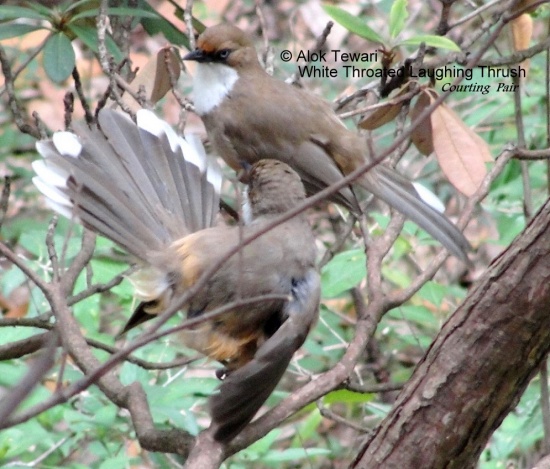Alternative name: Collared Laughingthrush
- Garrulax albogularis
Includes: Rufous-crowned Laughingthrush
Identification
With 28 - 30.5cm a rather large Laughingthrush1, 3:
- Brown above, rufous dull forehead
- White throat patch
- Grey-brown breast band and cinnamon-buff belly and vent
- White eye in blackish face
- ruficeps has a rufous crown and nape
Distribution
Found in Southeast Asia. In the Himalayas from Pakistan (now probably extinct) over Kashmir, India, Nepal and Bhutan to SC and S China and Taiwan.
Common in most of its range.
Taxonomy
Clements2 accepts four subspecies:
- G. a. albogularis in the Himalayas
- G. a. whistleri in Kashmir, Pakistan and NW India
- G. a. eous in SW China
- G. a. ruficeps on Taiwan
The form ruficeps is split by some authorities and named as Rufous-crowned Laughingthrush, Garrulax ruficeps, endemic to Taiwan. Furthermore they don't accept the remaining subspecies and treat this species as monotypic. The described subspecies laetus from China is usually not treated as valid.1
Habitat
Broadleaf evergreen forest, deciduous forest, coniferous forest, also secondary growth and scrub. Has been recorded in fields. Breeds mainly above 1200m.1
Behaviour
Feeds on insects, however outside the breeding season the birds take also seeds and berries. Feeds mainly on ground. Usually encountered in groups of 6 - 15 birds, in winter sometimes more. Often found with other species in bird-waves, including other Laughingthrushes.1
Breeding season is from March to July. The nest is placed in a bush or on a horizontal tree branch, usually 1 to 4 m above ground. It's a shallow saucer made with dry grass, dead bamboo, leaves, twigs and roots. They lay 2 - 4 eggs.1
The species is resident, although some altitudinal movement occurs. In Bhuthan for example they move from 1400m - 3200m in summer to below 2800m, sometimes down to 800m in winter.1
References
- del Hoyo, J., Elliott, A. and Christie, D.A. eds. 2007. Handbook of the Birds of the World. Vol. 12. Picathartes to Tits and Chickadees. Barcelona: Lynx Edicions. ISBN 84-96553-42-6
- Clements James F. 2007. The Clements Checklist of Birds of the World. 6th ed., with updates to October 2007. Ithaca: Cornell University Press. ISBN 9780801445019
- Rasmussen, P.C. and Anderton, J.C. 2005. Birds of South Asia. The Ripley Guide. Washington D.C. and Barcelona: Smithsonian Institution and Lynx Editions. ISBN 84-87334-67-9
Recommended Citation
- BirdForum Opus contributors. (2024) White-throated Laughingthrush. In: BirdForum, the forum for wild birds and birding. Retrieved 27 April 2024 from https://www.birdforum.net/opus/White-throated_Laughingthrush




